On 24 August 79 AD, the city of Pompeii, which was part of the Roman Empire, was destroyed by the eruption of the volcano Mount Vesuvius. 16 years previously, a massive earthquake had badly damaged the buildings, and the city was still being rebuilt at the time of the eruption. It came so quickly that Pompeii was rapidly covered in ash to a height of between 4 and 6 metres (13 to 20 feet), preserving the city just as it was and killing some people as they tried to escape.
Pompeii had been a wealthy city due to the rich agricultural land surrounding it and its position on a trading route. The city had swelled to a population of around 20,000 but only around 1,500 bodies were discovered when excavated, so we can only assume that the rest of the people escaped when the volcano erupted.
When Herculaneum, a nearby town that was also buried by the ash, was discovered in 1709, interest grew in the area, and Pompeii was also found. Excavations began in Pompeii in 1748, and it is still being excavated to this day.
Pompeii is near the city of Naples and covers a massive 160 acres (65 ha). If you want to see it all, you will need at least a day, if not more. Many beautiful villas have been excavated with frescoes intact. There are theatres, public baths, a forum, temples dedicated to the Roman gods, and an advanced aqueduct system that would have provided a clean water system. If you have decided to visit Pompeii but only have half a day, it can be difficult to decide what to see, so here are the best things to do in Pompeii.
Contents
- Pompeii, Italy
- Top Tours
- 20 Things To Do In Pompeii
- 1- Visit The Antiquarium
- 2- Take In The Atmosphere At The Amphitheatre
- 3- Explore The Forum
- 4- Visit The Forum Baths
- 5- Explore The Brothels
- 6- See The Temple Of Apollo
- 7- Visit The Villa Of The Mysteries
- 8- View The Stabian Baths
- 9- Visit The House Of The Faun
- 10- Explore The Large Theatre
- 11- Visit The House Of The Small Fountain
- 12- Stroll Through the Garden Of The Fugitives
- 13- Visit The Temple Of Isis
- 14- View The House Of Menander
- 15- Pay Your Respects At The Necropolis Of Pompeii
- 16- Visit The House Of Vettii
- 17- Explore The House Of The Tragic Poet
- 18- Visit The House Of Venus In The Shell
- 19- Explore The Palaestra
- 20- Visit The House Of Sallust
Pompeii, Italy
Top Tours
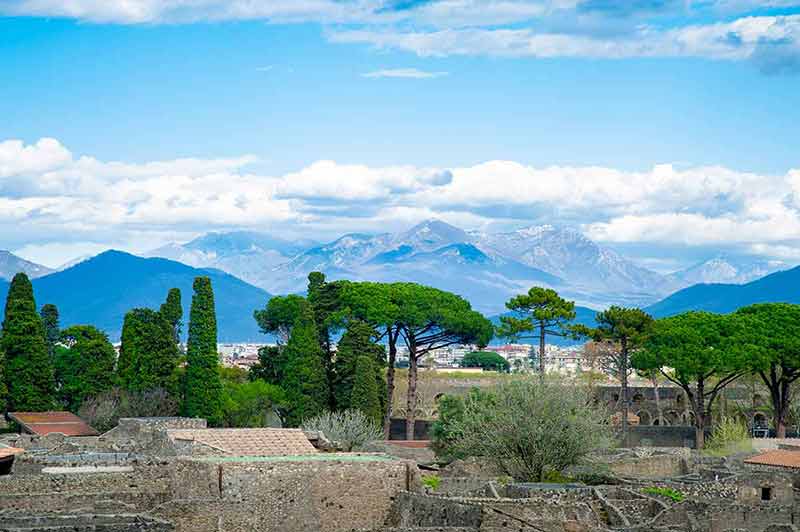
- Pompeii Ruins Skip-the-Line Small Group Tour – a popular group tour with a knowledgeable guide.
- Pompeii: Archeological Site Entry Ticket – buy your entry ticket here to avoid lining up.
- Pompeii: Happy Tour for Children – visiting with kids? Check out this fun tour for younger visitors.
20 Things To Do In Pompeii
1- Visit The Antiquarium
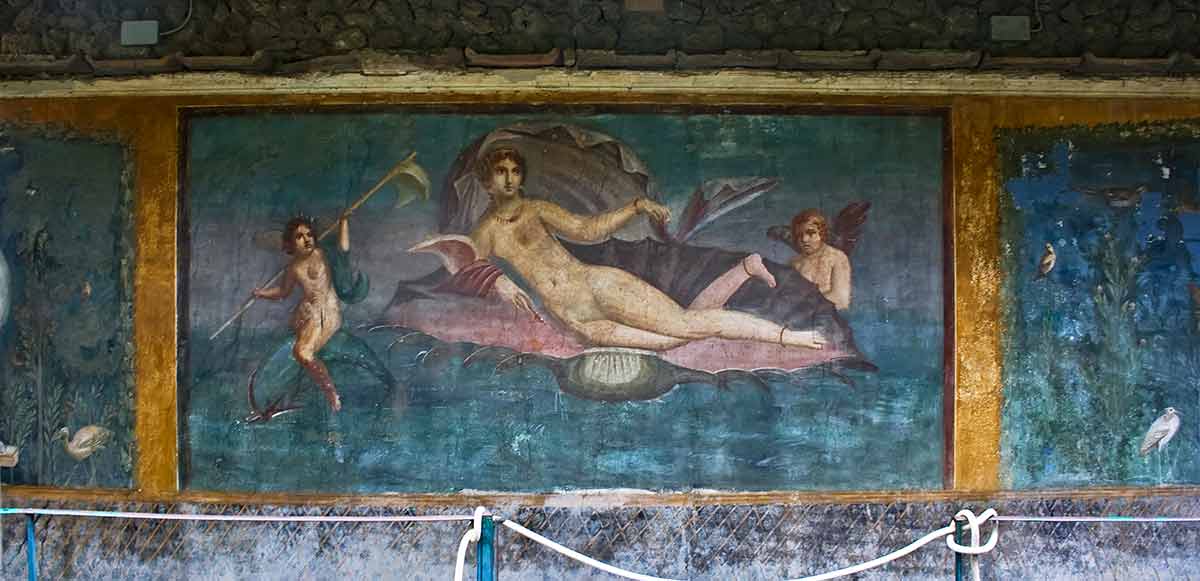
The Antiquarium is a museum, and while you might be itching to visit the city, it is worth your while to take a look around the museum first as some of the artefacts from the site have been removed and placed here.
You can see furnishings, household items, and Roman terracotta containers called amphora.
Highlights are the frescoes from the House of the Golden Bracelet and a triclinium, a dining table with couches on three sides, from the House of Menander.
Recently, excavators have found a large treasure trove of amulets, beads, gemstones, and pendants in the House with the Garden, now housed in the museum.
You will see the grim reality of the eruption when you come across the plaster casts of some of the bodies found in Pompeii.
They are images of the people in their last moments when they were trying to escape, and they can be upsetting.
Your visit to the museum can be accompanied by two different forms of digital media, an audio narration or a web bot.
No plans to visit Pompeii? You can travel there as a day trip:
- From Rome: Pompeii and Mount Vesuvius Day Trip
- From Naples: Pompeii and Vesuvius Guided Day Trip with Lunch
- From Sorrento: Skip-the-Line Pompeii Express Tour by Train
2- Take In The Atmosphere At The Amphitheatre
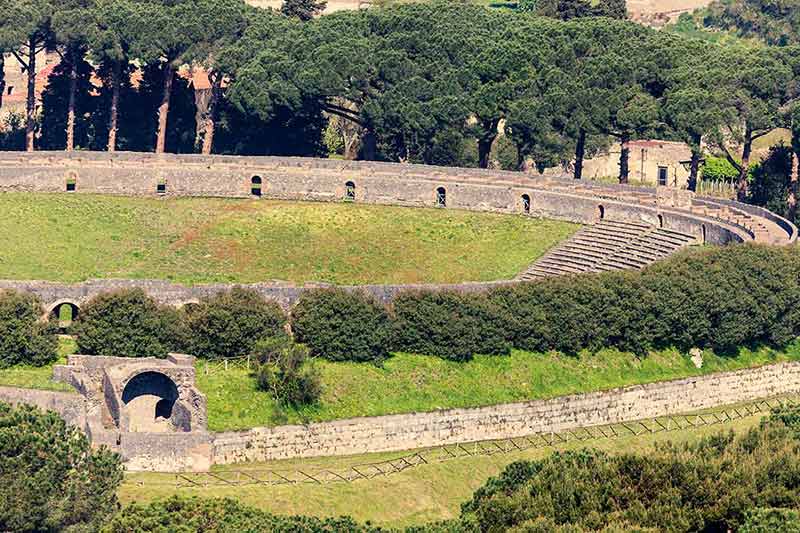
The Amphitheatre in Pompeii was built in 70 BC and is the oldest Roman amphitheatre that has been found to date.
It was a popular venue for citizens of all classes who went there to watch circus shows and gladiator challenges.
It held up to 20,000 people, which was the city’s population.
The citizens were separated, with the higher classes taking their seats in the lower areas where they would be closer to the action.
The plebeians would sit higher up.
The Amphitheatre had a velarium, a cover stretching over the theatre to protect the audience from rain and extreme heat.
You can still see the rings to which the canopy was fixed.
The Amphitheatre is at the far end of the site, so it sees fewer visitors, especially in the morning and late afternoon, so this is a good time to go there.
The top part is still intact, so you can sit there and imagine what it was like when the gladiators fought.
The Amphitheatre is at Piazza Immacolata 80045.
Recommended tour: Pompeii: Archeological Site Entry Ticket
3- Explore The Forum
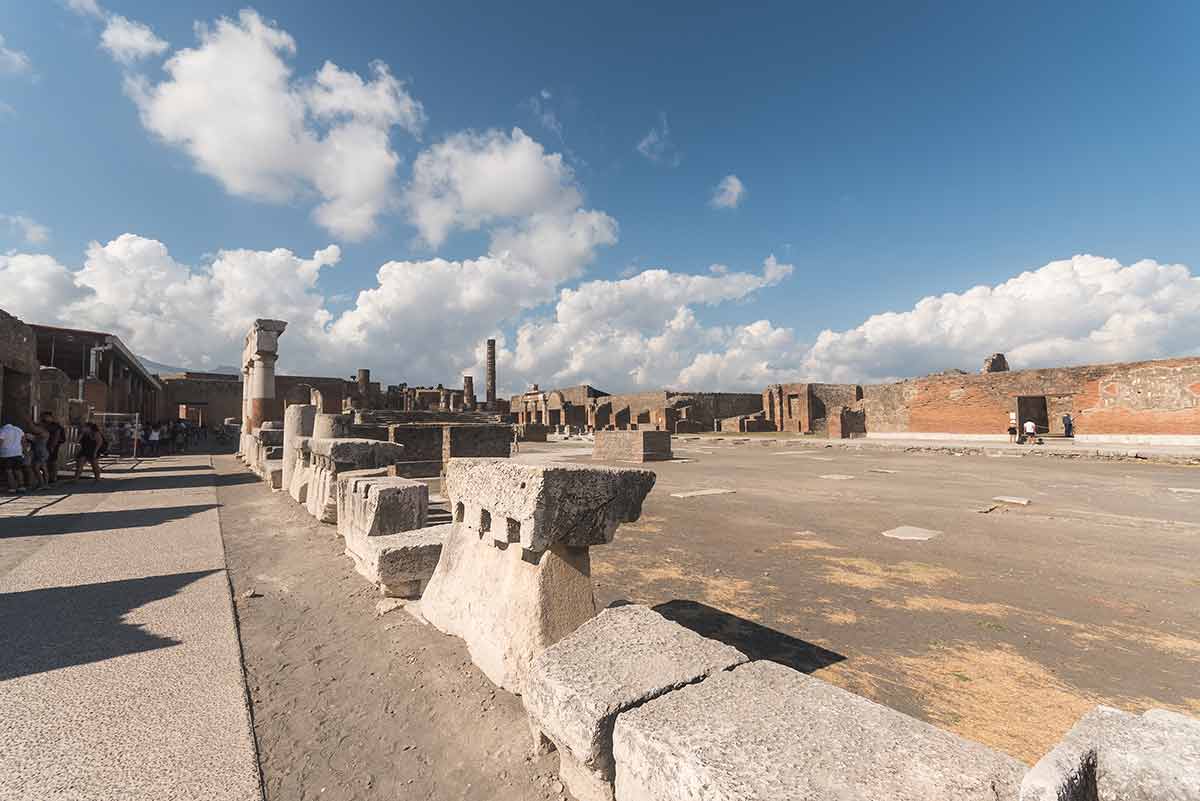
The Forum of Pompeii was, like all other forums in ancient Roman cities, the heart of the city.
It was the main square, and important religious, political, and commercial events would occur here.
The Forum is 157 metres (515 feet) by 38 metres (124.6 feet).
It is surrounded by colonnades, with a temple to the north dedicated to Jupiter, king of the Roman gods and god of the sky.
To the right, you will find the Macellum, an indoor market selling food, mainly fish and meat.
Shrines, temples and other buildings surround the Forum, such as the Temple of Vespasian, a Roman emperor who ruled in the 1st century AD.
There is also the Shrine of the Lares, the souls of the dead who were worshipped by the ancient Romans, a building that sold wool, and the Cuna, where the town council held its meetings.
The Forum was originally built in the 4th century BC but was just a simple square then.
It was modified in the 3rd and 2nd centuries BC when the ground was paved with volcanic tuff, and porticoes were added.
Unfortunately, it seems that looters stripped any ornamental decorations in ancient times.
The Forum is at Via Villa dei Misteri 2 80045.
Recommended tour: Pompeii: Small-Group Tour with an Archeologist
4- Visit The Forum Baths
There are several public baths in Pompeii, and the Forum Baths are the smallest.
However, they are the most beautiful and well-preserved, so they are well worth visiting.
They are just behind the Temple of Jupiter and were built around 80 BC.
However, they were damaged in the earthquake of 62 AD, and you see the restored baths now.
As in most public baths, the men and women had separate rooms with their own entrances.
At the Forum Baths, the men’s bathing rooms were larger than the women’s, indicating that women were inferior to men.
The men’s baths have a dressing room with a tepidarium for medium-temperature baths, a frigidarium for cold baths and a caldarium for hot baths.
The dressing room for the women doubled as a frigidarium with a small pool of cold water.
The women’s baths were still being renovated when the volcano erupted, while the men’s rooms were elaborately decorated with beautiful wall and ceiling stuccos.
The niches for storing clothes are decorated with terracotta figures, murals, and reliefs throughout the Forum Baths.
Outside the men’s section, you will see around 500 lamps that were used during the evening sessions.
There are some narrow rooms between the men’s and women’s baths for bath employees who would bring firewood, water, wine, and food to the wealthy bathers.
It is interesting to see how far advanced Pompeii was for the time.
A system of underground furnaces heated the baths, and water was supplied from an aqueduct nearby.
The Forum Baths are at Via del Foro 26 80045.
Recommended tour: Pompeii Ruins Skip-the-Line Small Group Tour
5- Explore The Brothels
Prostitution was legal in Pompeii, and it was normal for men to visit brothels.
There are around 25 brothels in the city, the largest of which is the Lupanar, a two-storey building with ten rooms.
It is now one of the most visited buildings in Pompeii!
The walls are adorned with frescoes depicting erotic scenes, which could have represented a menu of services offered or, alternatively, an instruction manual for the less experienced clients.
The frescoes have been well-preserved by the volcanic ash.
It is thought that the rooms were dimly lit by candles to create a sensual atmosphere.
However, there is a tragic side to the brothels.
The women working in them were slaves who worked in tiny rooms and didn’t see the light of day.
Lupanar is at Via Villa del Misteri 2 80045.
6- See The Temple Of Apollo
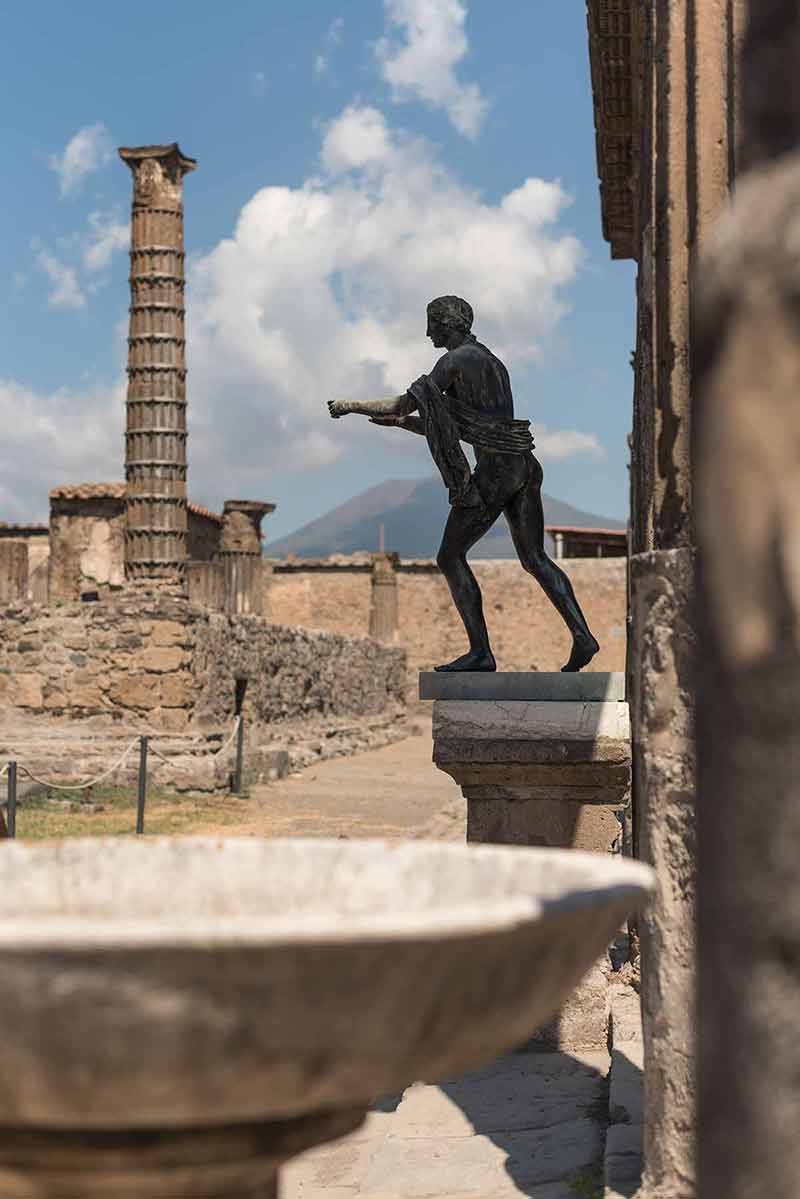
The god, Apollo, was worshipped in ancient Greek and Roman religions.
He was the son of Zeus and had a twin sister, Diana, the goddess of the hunt, known as Artemis in Greece.
The Temple of Apollo is one of the oldest temples in the city and was originally built in the 6th century BC.
It was then renovated between the 3rd and 2nd centuries BC.
It has Roman and Greek features, such as the Italian elevated podium and the Greek colonnade surrounding the cella, where an image of Apollo was kept.
The floor is beautifully made with coloured diamond-shaped stones.
You will see a sundial that dates to the Augustan age from 43 BC to 18 AD.
There are copies of bronze statues of Apollo and Diana, the originals of which are now housed in the National Archaeology Museum of Naples.
It is believed that gladiator contests and plays honouring Apollo and Diana were frequently held here.
The Temple of Apollo is at Via Villa dei Misteri 4 80045.
7- Visit The Villa Of The Mysteries
The Villa of the Mysteries was built in the 2nd century BC, and although it was damaged in the earthquake of 62 AD, the frescoes and mosaics were retained in excellent condition and not even the eruption of Mount Vesuvius damaged them.
They remain some of the best examples of 1st-century BC art.
In the dining room, there is a frieze that has almost life-size figures.
Another fresco depicts a bride being initiated into a Greco-Roman cult.
After the earthquake, the villa became a farmhouse that produced wine.
It wasn’t uncommon for the rich to have vineyards, orchards, and olive groves by their villas.
A wine press was found here and has been restored.
Recommended tour: Pompeii: Happy Tour for Children
8- View The Stabian Baths
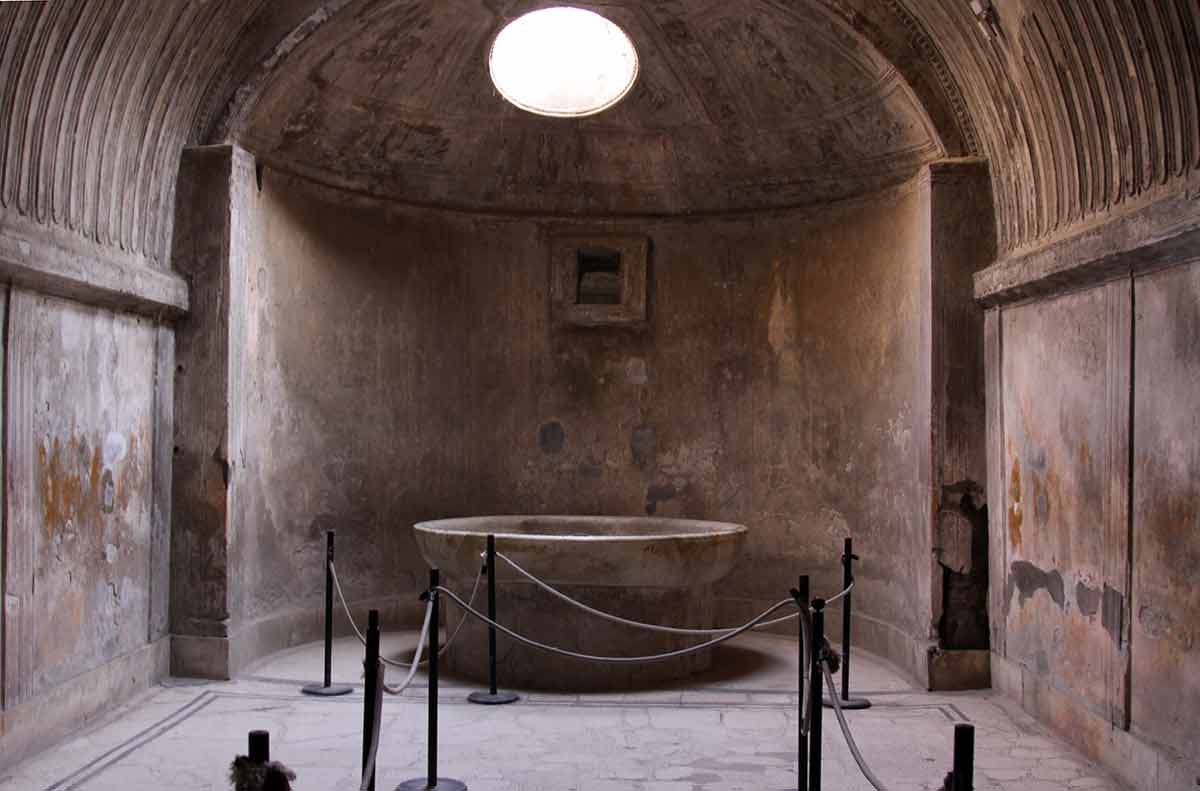
The Stabian Baths are the largest and oldest public baths in Pompeii.
They date back to 125 BC but were refurbished several times before the volcanic eruption.
As in all public baths, men and women had separate entrances and baths.
The men’s baths were larger and were elaborately decorated, something missing from the women’s baths.
Even though the Ancient Romans were way ahead of their time, they still treated women as second-class citizens.
The men’s baths have a changing room, cold room, temperate room, hot pool, and a swimming pool.
The women’s baths, however, didn’t have a cold room.
Instead, they had a basin with cold water in their dressing room.
There was also a gym in the building where gladiators would train and a large swimming pool.
You can see some preserved bodies here.
They were trying to escape from the volcanic eruption, which is another reminder of the tragedy that happened.
The Stabian Baths are at Via del Foro 26 80045
9- Visit The House Of The Faun
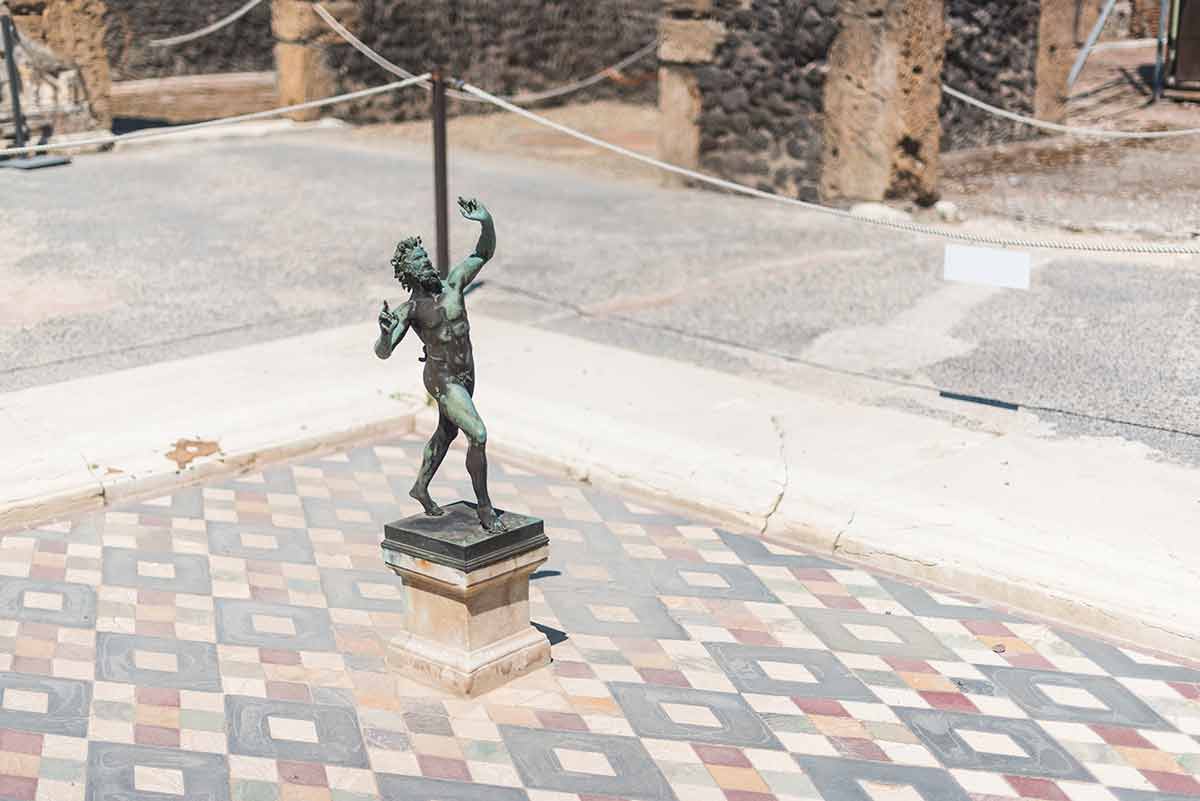
The House of the Faun was one of the most luxurious houses in Pompeii.
It covers a massive 3,000 square metres (32,291 square feet) and was built in the 2nd century BC.
It gets its name from the faun statue in the front courtyard.
The house has some amazing works of art, although most of what you see are copies.
The originals are housed in the National Archaeological Museum of Naples.
A large courtyard at the back of the house has a detailed mosaic of a battle scene.
The front door is framed with pillars, adorned with decorative letters, and the entrance floor has yellow, green, red, and pink marble triangles.
Inside the house, there are small temples in relief, elaborately decorated reception rooms, and, in the living room, a copy of a mosaic depicting a battle between Alexander the Great and the Persian King, Darius.
The House of the Faun is at Via Villa dei Misteri 2 80045.
10- Explore The Large Theatre
The Large Theatre, or Teatro Grande, isn’t as big as the Amphitheatre but still holds around 5,000 people.
It was built in the 2nd century BC and performances of both tragedies and comedies were held here, as well as music and dance.
In addition, political meetings were conducted in the theatre.
It is still used now in the summer for Son et Lumiere performances.
If you sit in one of the top rows, you will get a fantastic view of the city and of Mount Vesuvius.
At the Large Theatre, you will see the contrast between the rich and the poor.
The upper classes had much wider seats and were separated from the lower classes, who had narrow seats.
Next to the Large Theatre is the Teatro Piccolo, the Little Theatre, which is well-preserved.
It was built around 75 BC, was the first Roman theatre to have a roof, and was used for musical shows.
The Large Theatre was the first large building to be excavated after the volcanic eruption, and you can now see that a recess in the hillside was used to create the horseshoe shape of the theatre.
A wall surrounds the stands, and the theatre had a canopy for bad weather.
Close to the theatre, you will find a large space enclosed by porticos that is thought to have been a foyer.
Some weapons were found here, so it the foyer was probably also used as gladiator barracks.
11- Visit The House Of The Small Fountain
Although this house is small, it is impressive.
It belonged to a well-off family, and the architecture is beautiful.
There are stunning frescoes inside, and it houses the famous fountain, the main reason tourists flock to the villa.
The fountain is elaborately decorated with mosaics and shells, and you will see a copy of a bronze statue of a fisherman and a cherub that was originally here.
The work is finely detailed, and the fountain is an impressive piece of work.
The walls of the house are frescoes with landscapes, including one of a seaside town.
The roofs of the ceilings have been restored, so you can now get an idea of the size of the house.
The House of the Small Fountain is at Vicolo Di Mercurio 80045.
12- Stroll Through the Garden Of The Fugitives
You will find the Garden of the Fugitives at the back of Pompeii.
There were houses here at one time, but before the volcanic eruption, it was turned into a vineyard with a triclinium for banquets.
The story here focuses on the tragedy of the lives lost in 79 AD.
When the volcano erupted, 13 people here tried to escape, but their flight was ended by the pyroclastic flow, which asphyxiated them.
You will see plaster casts of their bodies in the positions they died in, often frozen in fear.
They are kept in a glass case at the back of the garden to preserve them.
13- Visit The Temple Of Isis
The Temple of Isis was built in the 2nd century BC but was destroyed in the earthquake of 62 AD and rebuilt.
It is situated on the east side of the Little Theatre.
Isis was an Ancient Egyptian goddess who was also worshipped by a cult in the Roman Empire, mainly composed of the lower classes.
Legend has it that Isis found the dismembered parts of her husband’s body, put them back together, and revived him.
The temple is built on a raised base in a courtyard surrounded by porticoes.
When it was excavated, the decorations and furnishings were almost intact.
However, the furnishings and statues are now kept in the National Archaeological Museum of Naples.
Inside the temple, you will see an altar and a pit for offerings to the goddess.
A staircase leads to a water pit where water was taken for the offerings.
Behind the temple is a hall where the initiates of the cult met.
Mozart visited Pompeii in 1770 and was so impressed with this temple that it inspired scenes of his ‘Magic Flute’ opera.
The Temple of Isis is at Via del Tempio di Iside 30 80045
14- View The House Of Menander
This house belonged to a rich merchant, and it has been well-preserved by the volcanic eruption.
It got its name from the picture of the Athenian playwright Menander in the portico.
However, the house belonged to Quintus Poppaeus Sabinus, a relative of Poppea Sabina, the second wife of Nero.
The entrance to the house is elaborate, with the door flanked by pillars bearing Corinthian capitals.
The atrium, which is the central courtyard, has a small temple in one corner.
There is a rhodium-shaped peristyle or colonnade surrounding the courtyard.
The interior rooms are painted with scenes from Homer’s Iliad.
The south side of the house is more rustic, and a wagon has been reconstructed here.
There is a basement below the house where a box containing 118 pieces of silverware was found.
These are displayed in the National Museum of Naples.
The House of Menander is at Via Villa dei Misteri 80045
15- Pay Your Respects At The Necropolis Of Pompeii
In ancient times, the dead weren’t buried within the city walls but just outside them.
You will find graves and tombs on the other sides of the gates leading into Pompeii.
The graves had to be at least 30 metres (98 feet) from the city walls.
The earliest graves date back to the 5th and 4th centuries BC, which can be found outside the Herculaneum Gate.
The dead were placed in graves in stone coffins with the goods they wanted to take into the next life.
Most of the people buried here came from upper-class families.
To the north of the city, leading out of the Vesuvius Gate, on the road heading towards the volcano, you will find tombs of aristocratic citizens which have been decorated with beautiful paintings.
Lower-class citizens and members of the Praetorian Guard were buried in the necropolis of the Noia Gate, many marked by memorial stones.
The famous Roman entrepreneur and priestess, Eumachia, from the 1st century AD, has her tomb in the necropolis of the Nocera Gate, but it is mainly lower and middle-class citizens buried here, including many freedmen.
A superb funerary monument was discovered in 2017 in the necropolis of the Stabiae Gate, and it is well worth looking at it.
It is covered with marble slabs and has a long inscription about the life of the deceased occupant, Alleius Nigidius Maius, a prominent politician and businessman who lived in the 1st century AD.
He was very popular with the citizens of Pompeii because he sponsored their beloved gladiatorial games.
16- Visit The House Of Vettii
The House of Vettii is one of the most extravagant and famous houses in Pompeii.
It belonged to two freedmen, Aulus Vettius Conviva and Aulus Vettius Conviva, who made their fortune through trade, showing that even the lowest classes could make something of themselves.
The rooms lead from an open courtyard where the colonnades still have their original marble decorations.
The garden in the middle of the courtyard has been planted to give you an idea of what it looked like in the 1st century AD.
The rooms are beautifully decorated with frescoes, the best ones in the dining room, where they completely cover the walls.
They depict mythological scenes, and there is a long frieze of cupids.
From the style, experts believe that these frescoes were painted after the 62 AD earthquake.
The House of Vettii is at Vicolo dei Vettii 80045.
17- Explore The House Of The Tragic Poet
The House of the Tragic Poet dates back to the 2nd century BC but it isn’t known whom it belonged to.
It is most famous for the mosaic at the main entrance, which says, ‘Cave Canem’ or, in other words, ‘Beware of the Dog’.
The atrium and tablinum contain beautiful mosaics, one of which depicts actors preparing for a play.
This inspired the name of the house.
In the living room, you will see mythological paintings, including scenes from Homer’s ‘The Iliad’.
Inside the house, you will find a shrine dedicated to the Lares, the souls of the dead that many ancient Romans worshipped.
They were asked for help with marriage, childbirth and death.
The frescoes and paintings that you will see are copies.
The originals are kept in the National Archaeological Museum of Naples.
The House of the Tragic Poet is at Vicolo Della Fullonica 80045.
18- Visit The House Of Venus In The Shell
The House of Venus in the Shell was built in the 1st century BC and belonged to a branch of the Satrii family.
It was going through a renovation when the volcano erupted and was then damaged during WWII.
It was restored in the 1950s.
The house is built around an open courtyard with a garden.
Rooms lead off the courtyard, and you will find beautiful frescoes in them.
At the back of the courtyard is a magnificent fresco of Venus, the goddess of love.
She is naked, wearing just a tiara and jewellery.
She is accompanied by two cherubs and is sitting in a shell.
On this wall, there is also a fresco of a beautiful garden with exotic animals and plants, one of a fountain with birds drinking from it, and one of Mercury, the god of financial gain, travellers, thieves and tricksters.
The House of Venus in the Shell is at Via dell’Abbondanza 80045
19- Explore The Palaestra
The Palaestra was built at the beginning of the 1st century AD and was intended to be a training ground for men and boys.
It is a large square, 140 metres x 140 metres (459 feet x 459 feet) in size.
It is surrounded by a wall which has 10 doors.
One of the doors leads to the Triangular Forum, where a track would have been used for races.
There were massive plane trees on three sides of the Palaestra but all that is left after the volcanic eruption are moulds of the roots.
When the site was excavated, bodies were found, no doubt trying to escape from the volcanic ash.
The Palaestra houses an exhibition of frescoes and artefacts found at the Complex of the Moregine Triclinia, a beautiful villa 600 metres (1968 feet) away from Pompeii.
The Palaestra is at Via Roma 44 80045.
20- Visit The House Of Sallust
The House of Sallust was a luxurious residence in Pompeii, probably belonging to Aulus Cassius Libanas.
Parts of the house were built in the 4th century BC but the main areas were constructed around 180 BC.
It has been very well-preserved by the volcanic ash.
The facade of the house is made of limestone blocks.
The inner courtyard, or atrium, has an impluvium, a water-catchment pool system made of volcanic tuff.
Inside the many rooms are original wall decorations.
It is thought that the house was turned into a hotel after the earthquake of 62 AD.
A second floor was built, and the decorations were renovated.
A bronze figure of Hercules, a mythical half-god known for his strength, was found, but it is now in the National Archaeological Museum of Palermo.
The House of Sallust is at Pompeii Scavi 80045.
Looking for more things to do in Italy? Here are some places you will love!
- 20 Landmarks in Italy
- 20 Best Beaches In Italy
- 20 Places To Visit In Italy In Winter
- 20 Incredible Things To Do In Lake Como
- 15 Things To Do In Rome At Night
- 21 Things To Do In Turin
- 15 Things To Do In Venice
- 20 Italian Drinks And Cocktails
- 24 Best Beaches In Sicily
- 20 Venice Night Attractions
- 20 Things To Do In Milan At Night
- 20 Things To Do In Florence At Night
- 20 Things To Do In Sicily
- Venice in Winter
- 20 Fairytale Castles In Italy
- 15 Italian Movies On Netflix
- 15 Italian Shows On Netflix
- 6 Charming Towns in Puglia
- Sacro Monti di Varallo
- Hiking Stromboli
- Salone del Gusto – Slow Food Festival
- 20 Things To Do In Florence
- 20 Beaches In Malta
- When Is The Best Time To Visit Italy?
- 20 Italian Cities
- 20 Things To Do In Pisa
- 20 Things To Do In Pompeii
- Where To Stay In Venice
- Where To Stay In Cinque Terre
Plan Your Trip

Rent A Car – Find the best car rental rates at Discover Cars. They compare car hire companies to provide you with the best deal right now.

Find A Hotel – If you’re curious about this article and are looking for somewhere to stay, take a look at these amazing hotels.

